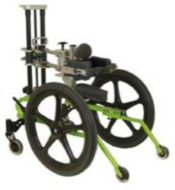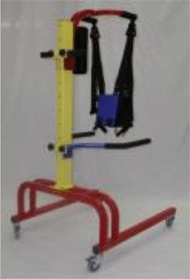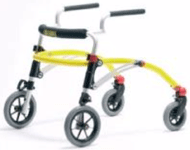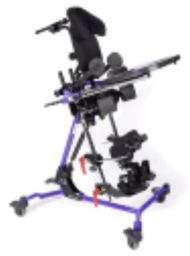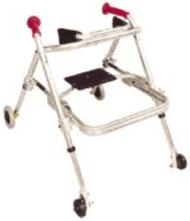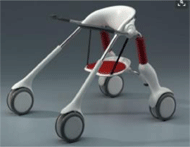Design Consideration On Pediatric Walkers For Children With Cerebral Palsy
Hongwu Wang1, Charlotte Dzul-Garcia1, Regan Bolding1, Brycen Raybon1
1University of Oklahoma Health Sciences Center, College of Allied Health, Department of Rehabilitation Sciences
INTRODUCTION
Cerebral palsy (CP) is caused by a brain injury at or around birth with a group of permanent disorders of movement and posture leading to activity limitation. The neurological and physical capabilities vary from child to child, therefore, the supports needed to assist with gait are wide ranging. Walking aids improve efficiency, stability and posture. It is estimated that 11.3% of children with CP use a hand held mobility device (including sticks, crutches and walkers).[1] Currently, there are several versions of pediatric walkers on the market, either anterior or posterior. Based on literature, velocity, truck flexion/pelvic tilt, and stability may be improved by using a posterior walker and the majority of walking aid users and their parents preferred posterior walkers, yet no clinical recommendations can be made for whether anterior or posterior walkers are preferable for children with CP based on existing evidence.[2] Further, a recent systematic review reported that there is a huge lack of evidence on the possible effect of pediatric walker on child development.[3, 4] The possible reasons for lack of support on child development could be due to the precocious locomotion provided which may interfere with the natural process on child development, [5] and the current pediatric walker design may prevent visual experience of moving limbs.[6] The goal of this study is to gather information about current pediatric walkers used by children with CP or recommended by pediatric therapists, determine what is available, and what alterations and additions are needed by interviewing therapists who working with children with CP for future pediatric walkers that will best fit the mobility needs of children with CP.
METHODS
A scoping methodology was used to identify literature on pediatric walker features, descriptive articles providing clinical rationale for pediatric walker features, and design and development paper for new pediatric walker design. An internet search was undertaken to identify a wide range of pediatric walkers currently available. We also gathered information by exploring current pediatric walkers and similar assistive technology currently available on the market from various medical supply stores, pediatric equipment providers, etc. We then interviewed experienced occupational and physical therapists, via phone or in person interviews, to draw from their clinical expertise of current pediatric walkers, as well as, working with children with varied types of cerebral palsy. Our interview questions gathered information about the therapists’ previous clinical experience and what ideas they have to improve the current designs of pediatric walkers to best fit the needs of all children with CP. We also asked the therapists about their perspective on the benefits and downfalls of current pediatric walkers and their recommendations for future equipment designs.
RESULTS
We identified four recent review papers on pediatric walker. [2-4, 7] Paleg and Livingstone, Badihian et al., and Poole et al. discussed the benefits of the pediatric walker, and various functional evidence of the pediatric walkers. Therapists in general agreed the benefits of early mobility with an emphasis on gait training, such as promoted joint and bone development, prevention of contractures and increases motion, improved lung function, better bowel and bladder function, better circulation, decreased constipation, decreased spasticity, lower risk of pressure sores, improved cognition growth with environmental exploration, improved visual awareness, improved socio-emotional and psychological aspects, and a more active lifestyle. However, evidence supporting selection of gait trainer styles and features for children with cerebral palsy is very limited.
When exploring pediatric walkers currently available on the market from various medical supply stores, pediatric equipment providers around metropolitan area of Oklahoma City, and recommendations from therapists, we analyzed and compared seven popular pediatric walkers as shown in Table 1. The Kidwalk and Kaye walker are current devices that facilitate gait, but do not specifically support the transition from sitting on the floor to standing. The Voyar Frog is a newer prototype of a pediatric walker that facilitates the sit-to-stand motion. Other pediatric walkers are more in the realm of gait trainers, forcing the child upright through a series of straps in conjunction with a large standing frame. According to the current market, pediatric walkers appear to have too much external support, along with not allowing the child to fall and interact with the typical surrounding environment. Children with CP have a wide spectrum of mobility needs. Considering the range of these needs, an adaptable pediatric walker with varied capabilities and features is needed.
We interviewed seven occupational and physical therapists with at least one-year working experience in children with CP. After analyzing our interviews with the therapists, we compiled this list of features that would be able to meet the needs of a wide population of children with CP as shown in Table 2. The rating of importance of each feature was defined as total number of the therapists suggested the feature. We also concluded a pediatric walker to meet the needs of all children with CP is not available, and a product that entails the therapists’ suggestions as well as the ability for the child to use the device to aid in sit to stand and walking is needed.
Features
|
Importance ratings
|
|---|---|
Encourages child independence and willful movements
|
6
|
Portability/transportability
|
5
|
Support self-determination and independent position changes
|
4
|
Safety mechanism to support balance loss and falls
|
3
|
Intuitive, easy to use
|
2
|
Ease of set up
|
2
|
Support growth
|
2
|
Wheels for multiple environment
|
2
|
Customizable (colors, add-ons, etc.)
|
2
|
Sleek, not too medical looking
|
1
|
Durability
|
1
|
Affordable
|
1
|
DISCUSSION
The purpose of the pediatric walker is to facilitate gait training, promote developmental growth by providing supports to transition from sitting to standing and vice versa. Pediatric walkers provide the child a level of autonomy to explore the environment around them. Based on our research and discussions with experts in the field, there is not a current pediatric walker that meets all of the suggested criteria. Parents remained highly motivated to encourage their children to use these walking devices and appraised them very positively. They commented the benefits of pediatric walkers for increasing communication, participation and inclusion in activities with others.[8] Ideally, this walker, which is lightweight and transportable, could accommodate children with a wide range of mobility and involvement levels. The supports provided would inspire the child’s willful movements and allow them to use self-determination. Other imperative characteristics are that the walker is intuitive and easy to use. It should facilitate gait and safely allow the child to fall and stand back up. This walker could be rehabilitative, as well as, assistive, impacting therapists, the individual and family members alike. Theoretically, it would facilitate growth toward developmental milestones by providing opportunities to participate and be functionally mobile. Therefore, a new pediatric walker design is needed to meet the suggestions of the seasoned therapists to best suit the needs of children with cerebral palsy.
REFERENCES
-
Christensen, D., et al., Prevalence of cerebral palsy, co-occurring autism spectrum disorders, and motor functioning - Autism and Developmental Disabilities Monitoring Network, USA, 2008. Dev Med Child Neurol, 2014. 56(1): p. 59-65.
-
Poole, M., et al., Anterior or posterior walkers for children with cerebral palsy? A systematic review. Disabil Rehabil Assist Technol, 2018. 13(4): p. 422-433.
-
Paleg, G. and R. Livingstone, Outcomes of gait trainer use in home and school settings for children with motor impairments: a systematic review. Clin Rehabil, 2015. 29(11): p. 1077-91.
-
Badihian, S., N. Adihian, and O. Yaghini, The Effect of Baby Walker on Child Development: A Systematic Review. Iran J Child Neurol, 2017. 11(4): p. 1-6.
-
Siegel, A.C. and R.V. Burton, Effects of baby walkers on motor and mental development in human infants. J Dev Behav Pediatr, 1999. 20(5): p. 355-61.
-
Lasky, R.E., The effect of visual feedback of the hand on the reaching and retrieval behavior of young infants. Child Dev, 1977. 48(1): p. 112-7.
-
Paleg, G. and R. Livingstone, Evidence-informed clinical perspectives on selecting gait trainer features for children with cerebral palsy. International Journal of Therapy and Rehabilitation, 2016. 23(9): p. 444-454.
-
Rossen, B.E., et al., The significance of uprightness: parents’ reflections on children’s responses to a hands-free walker for children AU - McKeever, P. Disability & Society, 2013. 28(3): p. 380-392.
3
